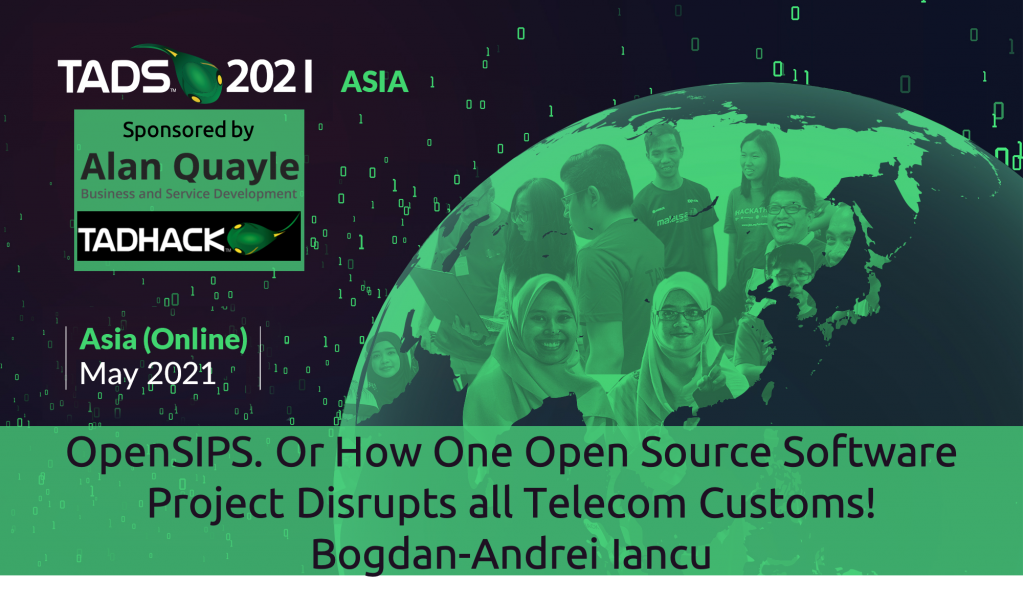Video
Outline: OpenSIPS. Or How One Open Source Software Project Disrupts all Telecom Customs!
Bogdan-Andrei Iancu, Founder and Developer at OpenSIPS Project
The Open Source Software paradigm is revolutionizing the telecoms world; in terms of IPR, licensing, and market value. Witness the explosion of new enterprise communication service providers such as RingCentral, 8X8, Talkdesk, Twilio, and many more; all using open source software.
To remain competitive in a fast changing telecoms market requires a change in ideology. Open Source Software helps realize the benefits of that change in ideology.
OpenSIPS, an open source VoIP software, is accelerating this ideological change. It is one software able to deliver almost the full spectrum of VoIP solutions: from SBCs, SoftSwitches to Virtual PBXes.
Come learn how OpenSIPS will help you compete over the coming decade.
Presentation Review
We’re excited Bogdan is back at TADSummit sharing a broader review of the impact OpenSIPS has across the entire telecommunications industry. Last year at TADSummit Asia Bogdan introduced OpenSIPS 3.1.
In this session Bogdan gives a nice overview of OpenSIPS, and frankly shares the benefits of using open source software, and the barriers he experiences to its adoption in the telecoms world that are more experienced with closed software / appliances.
OpenSIPS is a fully programmable and highly scalable open source SIP infrastructure software. After you download the software and set up an instance, you use scripts to configure what you need. You can set up a complete VoIP solution across SBCs, softswitches, and virtual PBX; all through scripts.
At TADSummit Asia 2021 we have a presentation “Introduction of ASTPP – A Smart TelePhony Platform” by Samir Doshi, ASTPP Community Leader; on how they use OpenSIPS to make ASTPP highly robust and scalable.
The value with open source isn’t the SIP infrastructure software, that’s free. It’s in the knowledge to implement what you require from OpenSIPS, backed by the support of a global community of fellow OpenSIPS users, who are all testing, enhancing, fixing, and updating the software.
Many in the telecoms industry are experienced with closed source appliances: a function that does X, and interfaces to another function that does Y. Its the ‘box and wires’ approach to telecom infrastructure design from the ’90s. But it’s now all just software, containers running on a private, public, or hybrid cloud.
Open Source, and OpenSIPS in particular, enable you to build a telecoms infrastructure based on modern software design principles, backed by a global community. Where you control the core value creation (scripts and implementation) to be able to operate in internet-time (changes made in hours/days) versus traditional box and wire telecom-time of months/years. The programmable communication industry (RingCentral, 8X8, Talkdesk, Twilio) has shown its possible.
OpenSIPS runs bootcamps so you can get up to speed quickly, and control your technology that is the core value for which your customers’ pay. You can see channels like Gamma buying the UCaaS/CCaaS tech company Mission Labs. Controlling your technology is a trend was evident throughout 2020 and into 2021. However, most businesses can not afford high M&A costs to buy-in the technology. Open source enables you to build-it and hence control it instead.
Thank you Bogdan for a frank and insightful presentation 🙂


Thank you for a great and insightful presentation. I have a few questions:
1) What are the most exciting applications of OpenSIPS you’ve seen in the past 18 months?
2) Owning your technology seems to be increasingly important for communication service providers. For example: the programmable communications industry, and the explosion of M&A through 2020 and into 2021. How can open source software help service providers own their technology?
3) What do you consider to be the most common barriers to adopting OpenSIPS? And how can they be overcome?
Thank you Alan, every year the TADAsia is an exciting event.
1) I will go for a technical answer here, no commercial tricks ;). OpenSIPS originally is a SIP proxy, SIP only (no media handling). Still, we are working on a project where OpenSIPS is a ……. call/audio stream demultiplexer – takes one SIP call with two audio streams and coverts them into two separate calls with one stream per call (for some call recording); that’s not a proxy anymore, not SIP only anymore – quite disruptive, right ?
2) I would say that technology transcends the idea of code-only. The technology is also the knowledge to use, to configure, to integrate. For a provider, the best asset is not the code itself, but the knowledge on how to use code (from FOSS) to built its services.
3) I think that most of the resistance (still, a futile resistance 🙂 ) comes from the business C-level where people fails to see the transition of the business value from licenses/code to knowledge. At this point the tech people, understanding and working with FOSS are the best evangelists – they see the real value of the FOSS and they are working out the adoption all the way up to C-level. What we can do, at projects level, is to show that FOSS is a mature and reliable resource for player, a resource you can safely use in building services and businesses.